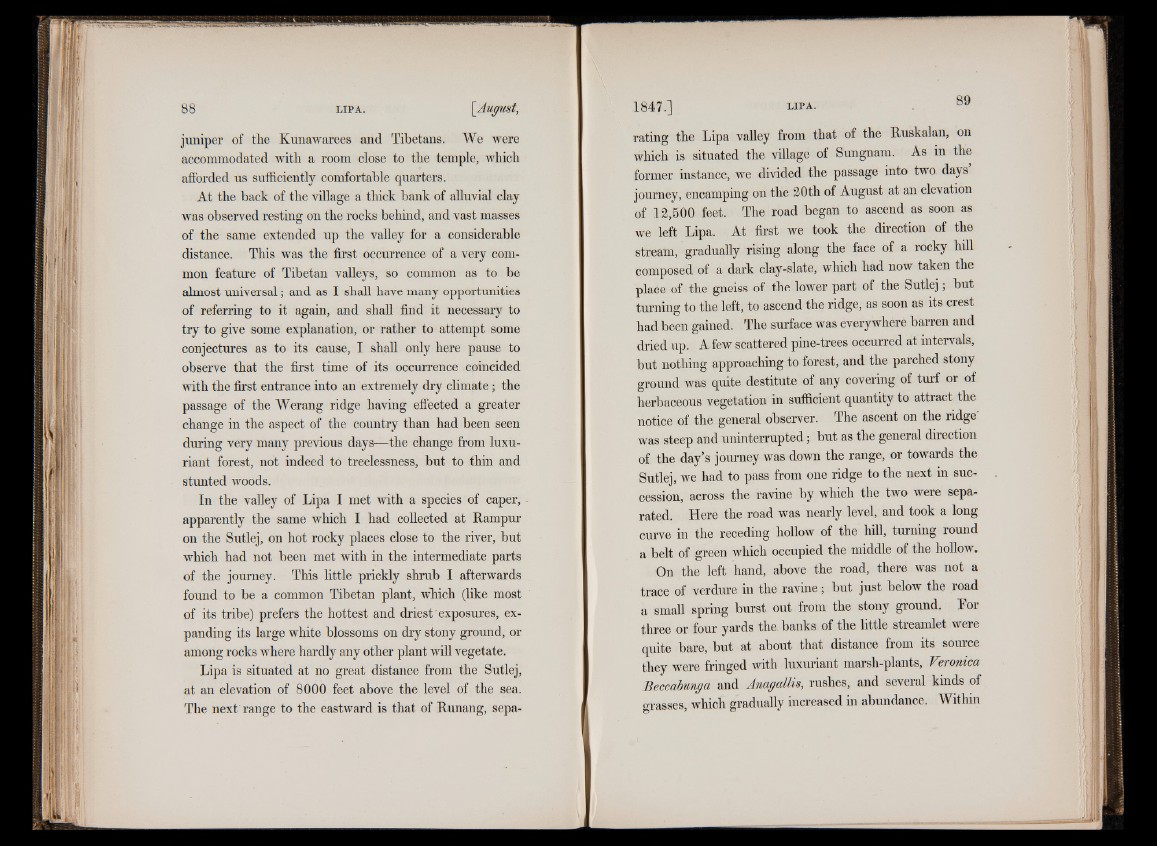
juniper of the Kunawarees and Tibetans. We were
accommodated with a room close to the temple, which
afforded us sufficiently comfortable quarters.
At the back of the village a thick bank of alluvial clay
was observed resting on the rocks behind, and vast masses
of the same extended up the valley for a considerable
distance. This was the first occurrence of a very common
feature of Tibetan valleys, so common as to be
almost universal; and as I shall have many opportunities
of referring to it again, and shall find it necessary to
try to give some explanation, or rather to attempt some
conjectures as to its cause, I shall only here pause to
observe that the first time of its occurrence coincided
with the first entrance into an extremely dry climate; the
passage of the Werang ridge having effected a greater
change in the aspect of the country than had been seen
during very many previous days—the change from luxuriant
forest, not indeed to treelessness, but to thin and
stunted woods.
In the valley of Lipa I met with a species of caper,
apparently the same which I had collected at Rampur
on the Sutlej, on hot rocky places close to the river, but
which had not been met with in the intermediate parts
of the journey. This little prickly shrub I afterwards
found to be a common Tibetan plant, which (like most
of its tribe) prefers the hottest and driest exposures, expanding
its large white blossoms on dry stony ground, or
among rocks where hardly any other plant will vegetate.
Lipa is situated at no great distance from the Sutlej,
at an elevation of 8000 feet above the level of the sea.
The next range to the eastward is that of Runang, separating
the Lipa valley from that of the Ruskalan, on
which is situated the village of Sungnam. As in the
former instance, we divided the passage into two days
journey, encamping on the 20th of August at an elevation
of 12,500 feet. The road began to ascend as soon as
we left Lipa. At first we took the direction of the
stream, gradually rising along the face of a rocky hill
composed of a dark clay-slate, which had now taken the
place of the gneiss of the lower part of the Sutlej; but
turning to the left, to ascend the ridge, as soon as its crest
had been gained. The surface was everywhere barren and
dried up. A few scattered pine-trees occurred at intervals,
but nothing approaching to forest, and the parched stony
ground was quite destitute of any covering of turf or of
herbaceous vegetation in sufficient quantity to attract the
notice of the general observer. The ascent on the ridge
was steep and uninterrupted; but as the general direction
of the day’s journey was down the range, or towards the
Sutlej, we had to pass from one ridge to the next in succession,
across the ravine by which the two were separated.
Here the road was nearly level, and took a long
curve in the receding hollow of the hill, turning round
a belt of green which occupied the middle of the hollow.
On the left hand, above the road, there was not a
trace of verdure in the ravine; but just below the road
a small spring burst out from the stony ground. Tor
three or four yards the banks of the little streamlet were
quite bare, but at about that distance from its source
they were fringed with luxuriant marsh-plants, Vironica
Beccabunga and Anagcdlis, rushes, and several kinds of
grasses, which gradually increased in abundance. Within